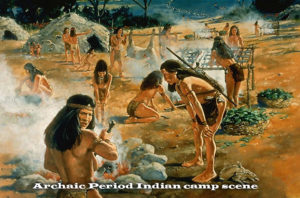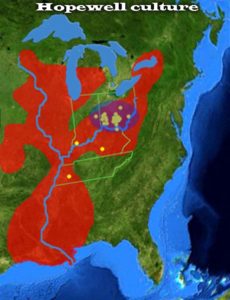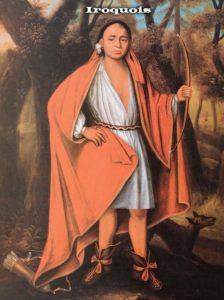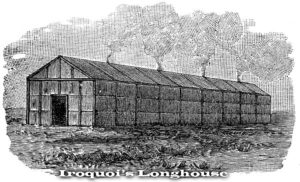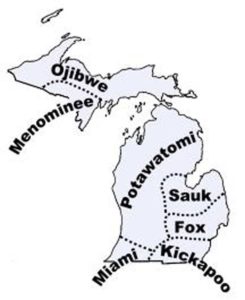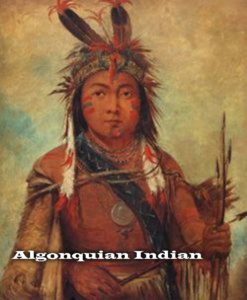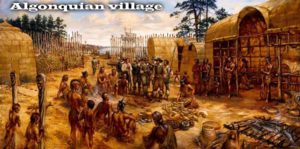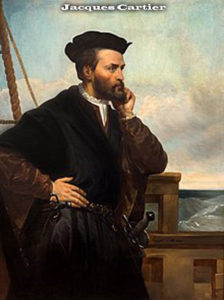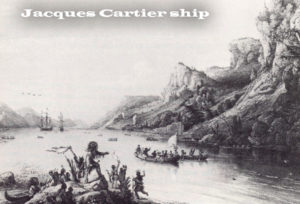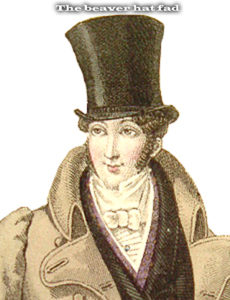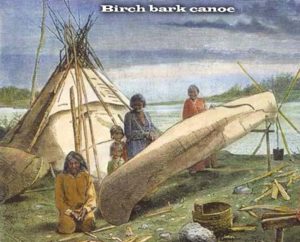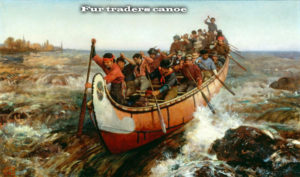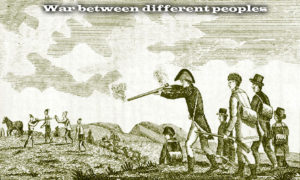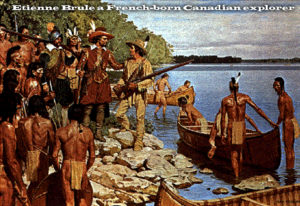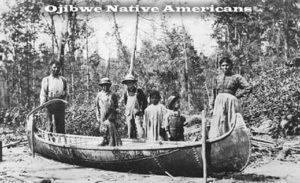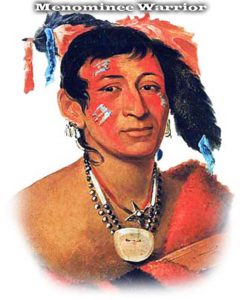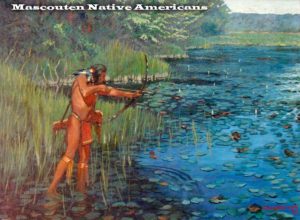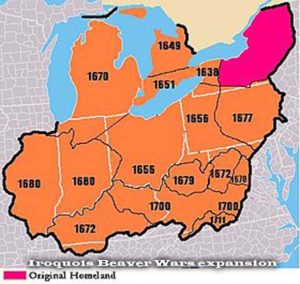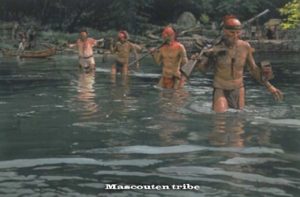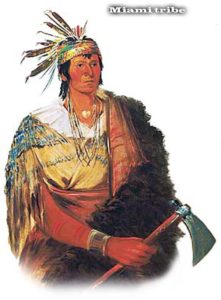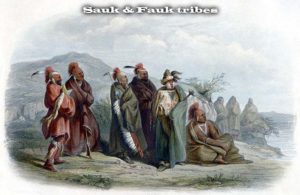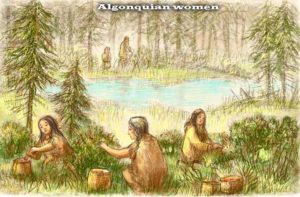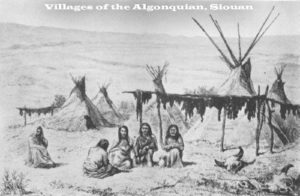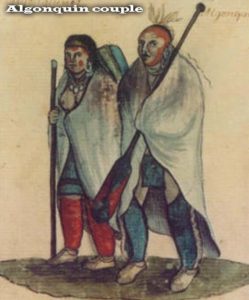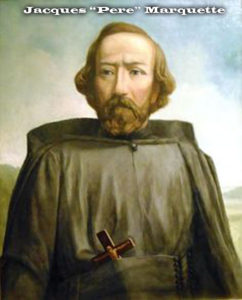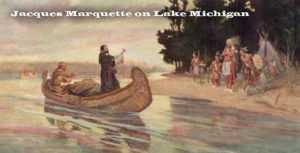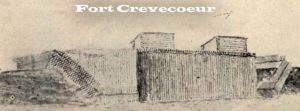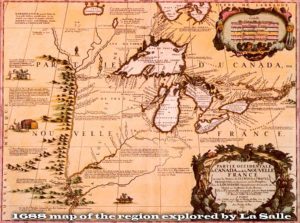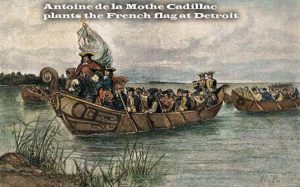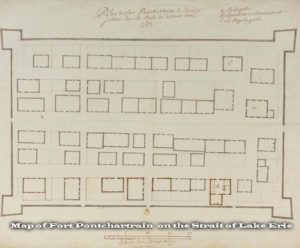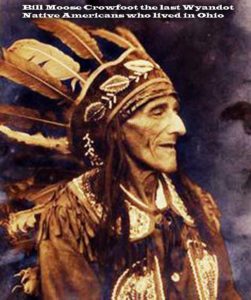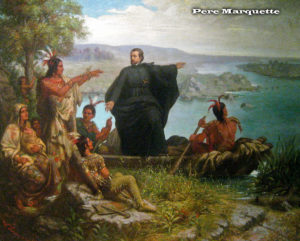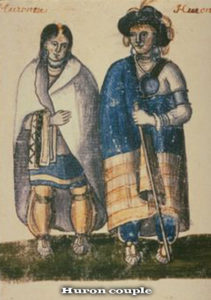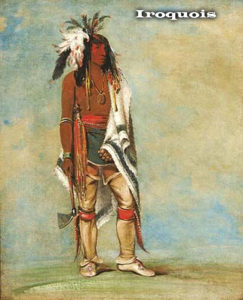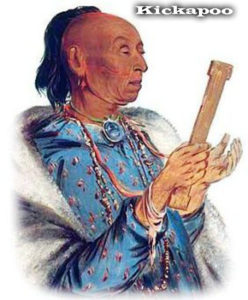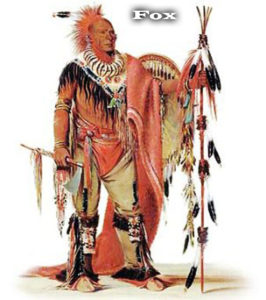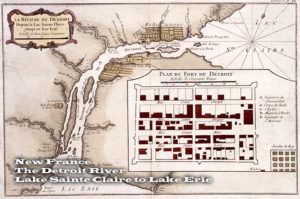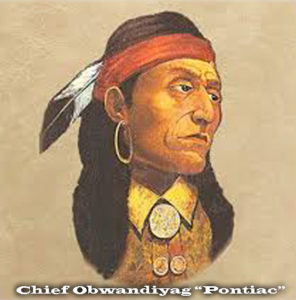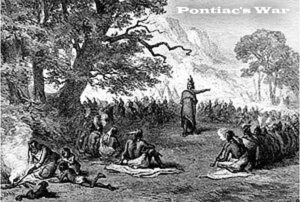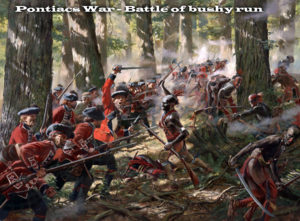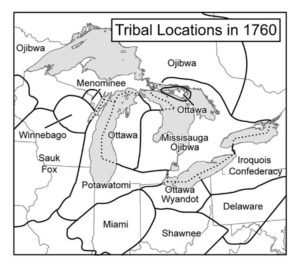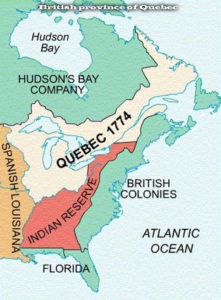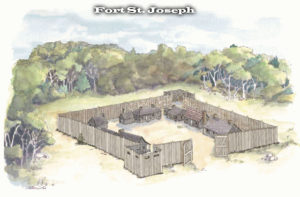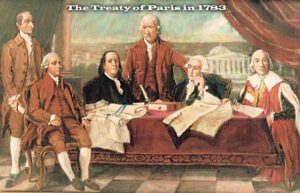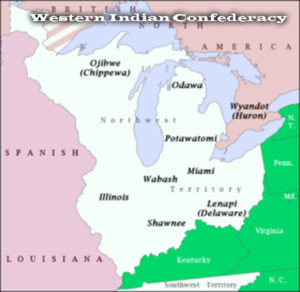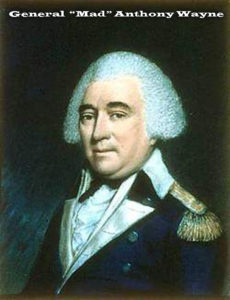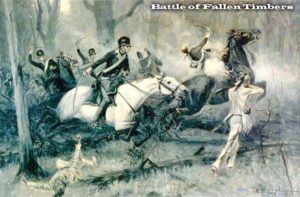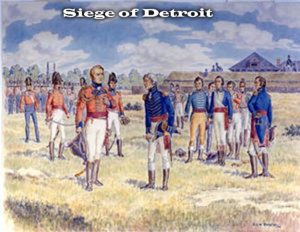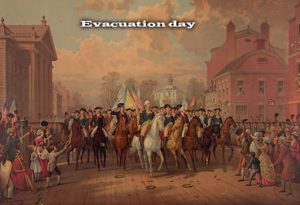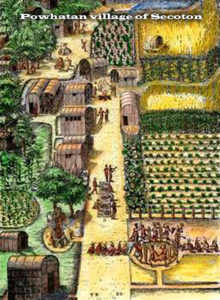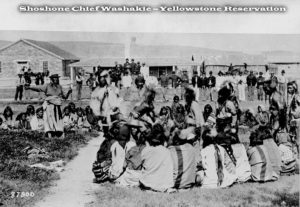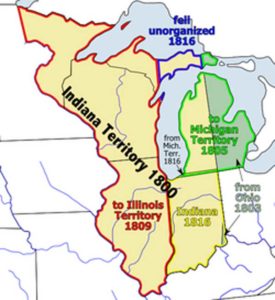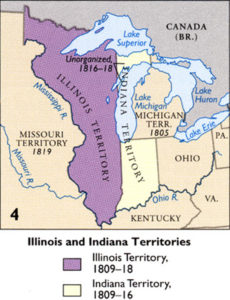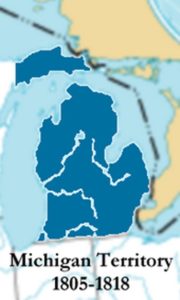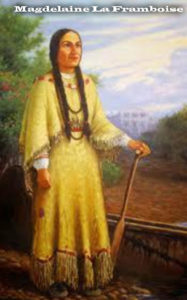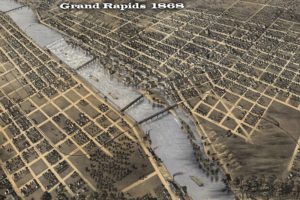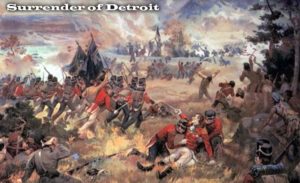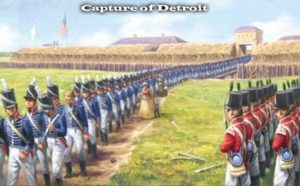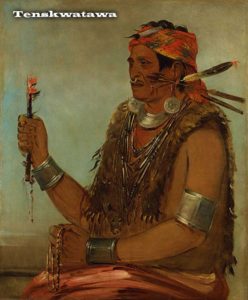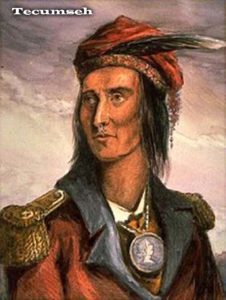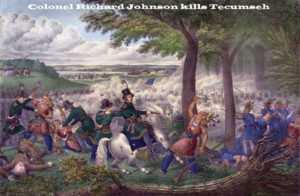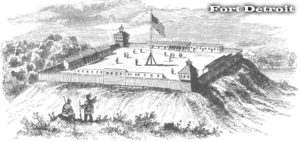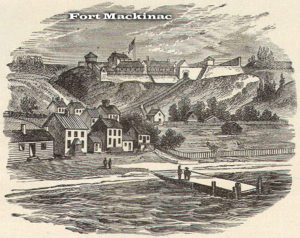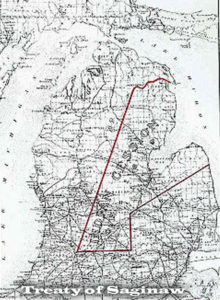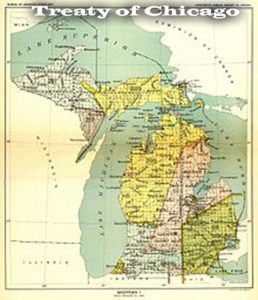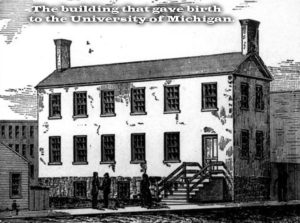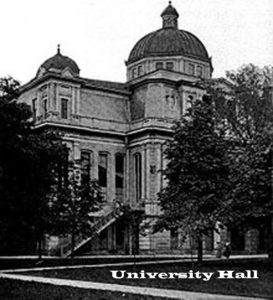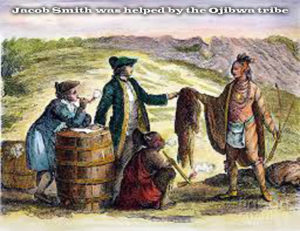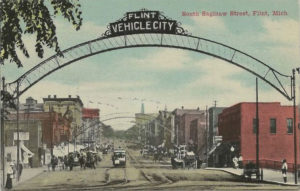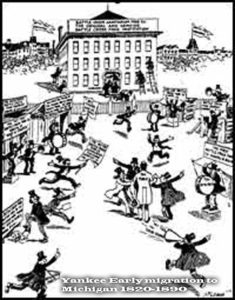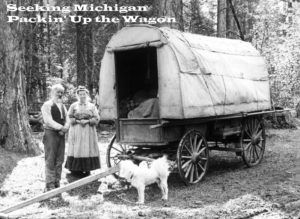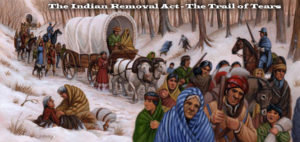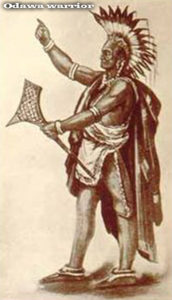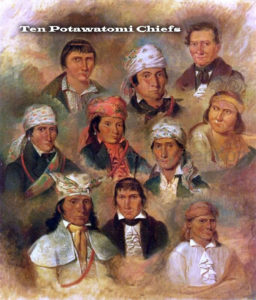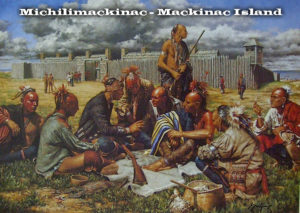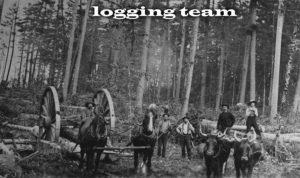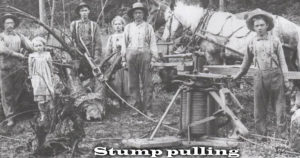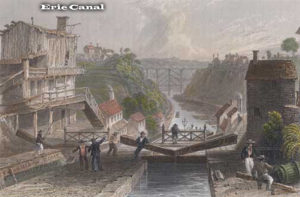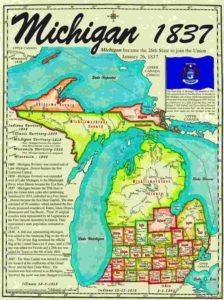As early as 11,000 BCE Native Americans were the first to settle in the western Great Lakes region. Over 5,000 years ago in the Middle Archaic Period the climate may have been significantly drier and warmer than it is in the modern age. Native Americans of the Hopewell tribes flourished along the rivers in early Michigan from 1000 B.C. to 1000 A.D.
“People of the Longhouse” were tribes of the Mohawk, Oneida, Onondaga, Cayuga, and Seneca nations that migrated from Canada around the 12th-13th centuries and took over the homelands of the Algonquian peoples of the East Coast. They were known as Iroquois to the settlers and they were part of a great northeast Native American confederacy. The Algonquian peoples were driven west and some inhabited Michigan.
The Algonquian-speaking “three fires” peoples the, Fox, Sauk, Kickapoo, Menominee, Miami, Ojibwe, Chippewa, and Potawatomi were driven west and some inhabited Michigan. The state got its name from the Algonquian word for “big lake.”
In 1534 Jacques Carter a French explorer discovered the St Lawrence River while looking for the Northwest passage, a water way to the Pacific Ocean. He started trading European goods to the Indians which they were eager to trade for beaver and other furs. The beaver hat fad had driven the beavers to extinction in Europe. A dozen beaver pelts could be traded for a gun or a cooking pot, knives and hatchets, all goods the Native Americans could not make for themselves.
In the spring Great Lakes fur traders and their native guide packed all trade goods they could into their Burch bark canoes and left Montreal and traveled west to Mackinac. They could expect to be gone for up to two years returning with their canoes full and pulling a small raft “loaded to, near sinking” with prime beaver pelts.
The fur traders had to watch out for Indian tribes that were hostile to the presents of strangers in their homeland. And depending on what nationality you were, whether French or English, you could be taken prisoner because these two countries were at war with each other fighting over who would control the fur trade in America.
A French-born Canadian explorer Etienne Brule emigrated to America in 1608 and he was the first European to travel through the province of Ontario. He lived with the Algonquin Indians, learned their language, and pioneered the role of translator between the French and the Native Americans including the Hurons.
Etienne Brule and Samuel de Champlain together explored the Great Lakes of Ontario in 1615 and Superior in 1622. He was killed and eaten by his adoptive tribe the Hurons and thereafter their folk lore predicted a long lasting “curse” for his murder.
The Ojibwe nation lived in the Upper Peninsula and the Menominee claimed the land along the boundary with Wisconsin. The Lower Peninsula was home to a mixture of Algonquian & Siouan peoples before the Mascouten claimed the whole Lower Peninsula as it’s homeland, but they lost it after the Beaver Wars.
In the 1640s during the Beaver Wars tribes that were allied with the French were pushed out of New York by the Iroquois toward Lake Huron. These tribes migrated to Michigan and declared war on the Mascouten and & Miami. The Mascouten left their homeland and migrated south and settled along the Wabash River in Ohio and Indiana.
A 1641 map refers to the Sauk & Fauk tribes that were chased into that region after their defeat back east with the Iroquois that were still moving westward, and they advanced into southern Michigan by the late1660s. The Ojibwe & Menominee tribes gave sanctuary and protected the Sauk & Fauk as then migrated west. This great movement of peoples fueled the flame of war for many years between the Algonquian & Siouan peoples.
The Algonquians called the great lake Michigan which translates to “cat which stalks below.” They were referring to the Iroquoian’s water deity “blue panther” after the way they conquered the entire southern peninsula for themselves and chased out other tribes.
In 1674 Jacques “Pere” Marquette a French Jesuit missionary and his two companions built a rough log cabin near the shore of Lake Michigan. In 1668 Father Jacques founded Sault Ste. Marie the first permanent European settlement in Michigan. He later founded St. Ignace.
In 1680 the French explorer La Salle founded Fort Crevecoeur the first European colony of Illinois and he lay claim for France all the territories between the Great Lakes, Ohio River, Mississippi River, to the Appalachian Mountains. This included all Upper and Lower Michigan.
During the late 1600s the French built several forts and trading post in Michigan. In 1701 fifty French-Canadians led by the officer Antoine de la Mothe Cadillac settled at Fort Pontchartrain du Detroit in New France. The French and their Native American allies expelled the Iroquois from the area. The were forced to sign a treaty distinguishing the Niagara River & Ohio-Pennsylvania borders as the boundaries of their lands
The continuous movement westward by white settlers pushed other tribes from Ohio. The Wyandot settled in southern Michigan.
French missionaries found the Mascouten living in the southern area of Michigan and they were said to be “more populous than the Huron and the Iroquois nations put together. They called their original homeland of the Erie Plains area, “Maskoutenich” or “The Treeless land.” In 1712 they joint with the Kickapoo and the Fox after nearly being eliminated by the French and the Potawatomi.
In 1760 the French lost their claim to the fort after their defeat in Quebec in the French and Indian War and they surrendered the area to the British who renamed it Fort Detroit. In 1763 the war ended with the signing of the Treaty of Paris. This treaty required the French to abandon all their North American colonies east of the Mississippi and Michigan’s future was handed over to the British.
From 1763 to 1766 Native Americans fought Pontiac’s War over the way they were treated by British postwar policies in the Great Lakes region. The fighting started at Fort Detroit led by Chief Obwandiyag “Pontiac” and it quickly spread all over the area as other Native Americans resisted British rule. Eight forts were victims to Pontiac’s warriors, but at Fort Pitt and Fort Detroit the British defenders held out.
By 1760 there were only a few hundred white settlers that lived off limited subsistence farming, hunting and trapping, and trading with the local Native American tribes. The British were more concerned with the fur trade and peace with the Native Americans than settling in the region. In 1774 the area became part of the British province of Quebec. The local American colonists rebelled against the British during the American Revolution because they supported an independent United States. The British and local tribes repeatedly attacked American settlements in the region in 1776.
In 1781 a French Captain Eugene Poure and sub-lieutenant Charles Tayon led sixty-five Spanish military men including sixty Indians from St. Louis by river and overland to liberated Fort St. Joseph from British control. The very next day they gave control of the fort over to the American settlers living there.
The Treaty of Paris in 1783 ended the American Revolutionary War and the United States lay clime to all the land east of the Mississippi River and south of Canada after the defeat of the British Army. Michigan passed into the control of the newly formed United States of American and it became part of the Northwest Territory from 1787 to 1800. The states of New York, Virginia, Massachusetts, and Connecticut yielded their regional claims to the territory.
Native Americans in the Great Lakes region joined together and formed the Western Indian Confederacy in an effort to challenge the expansion of the United States. Most of the tribes disagreed with the boundaries set by the new U.S. government and they would not obey the laws.
In 1794 a United States Army officer and statesman General “Mad” Anthony Wayne fought with his Kentucky marksmen against the Western Indian Confederacy allied with a British company and won the Battle of Fallen Timbers. His fighting achievements in battle and his blistering character quickly earned him advancement to brigadier general and the nickname “Mad Anthony.”
In 1786 the American flag was raised for the first time at Fort Detroit after the British troops withdrew from Detroit and Michilimackinac (Mackinac Island). One hundred years later Detroit celebrated “Evacuation Day” with patriotic speeches, a grand parade and fireworks.
With the Second Trade Act in 1793 it was mandatory that all Native American land sales required a federal license and permit. This also gave the President of the United States authority to appoint Indian agents to “guide them into acculturation of American society”. This was done by changing their traditional ways of farming and native day to day life. Most Native Americans were forced to leave their homelands in Michigan and relocate further west to U.S. Government Indian reservations.
In 1800 the state was cut in half with the creation of Indian Territory which included the western part of the state. The eastern part was included in the Northwest Territory boundaries.
In 1802 when Ohio was admitted to the Union as the 17th state, congress passed an act allowing the citizens of Ohio to form a state government and write their state constitution removing the state from the Northwest territory. In 1805 President Thomas Jefferson created the Michigan Territory.
The United States Congress established all the Lower Peninsula as Michigan Territory in 1805 and Detroit was the territorial capital.
In 1806 a French Roman Catholic Joseph La Framboise and his wife Madeline paddled a canoe from Mackinac to the banks of the Grand River and established the first trading post in West Michigan which became the city Grand Rapids.
The War of 1812 was fought between the United States and the British and their Indian allies. At the start of the war Canadian British military lay siege and captured the Forts at Detroit and Mackinac. This put the U.S. military at a tactical disadvantage with these heavy losses. The Native Americans that fought with the British shared in the success in these battles and this encouraged more native revolt against the United States.
Tenskwatawa “the open door” was the Shawnee spiritual leader of Prophet Town and his brother Tecumseh was the leader of the tribe. They allied themselves with the British against the U.S. Colonel Richard Johnson shoots and kills Tecumseh at the Battle of the Thames in 1813. When the war ended in 1815 Native Americans that had fought with the British were punished by forfeiting their lands to the U. S. Government.
That same year the United States military re-captured one of the gems of Michigan when it retook Fort Detroit. Another gem Fort Mackinac was not surrendered by the British until the end of the war in 1815.
When the war ended Native Americans that had fought with the British were forced to sell all their land rights to the U. S. Government by the Treaty of Saginaw and the Treaty of Chicago.
In 1817 the first institution of higher learning, the University of Michigan was founded in Detroit. The city of Ann Arbor presented land to the university and the school was moved to the new location in 1837.
In 1819 a fur trader Jacob Smith founded the village of Flint along the Saginaw Trail and it was a major part of the lumbering industry in Michigan. In the 20th century Flint was called “Vehicle City” because it was a leader in manufacturing of carriages and later automobiles.
New England settlers were among the first to arrive early in Michigan. Later in the 1820s thru 1830s there were large numbers of migrants that brought their New England culture to Michigan. These were “Yankee” settlers, decedents of the English Puritans from the colonial era.
The Yankees had large families some more than ten children. They left New England mostly because of overpopulation. Land became scarce due to massive and nonstop population boom that it was impossible for families to obtain their own piece of land to farm. Yankee settlers left New England because there was not enough self-sustaining farm land for every family.
In 1830 President Andrew Jackson signed the Indian Removal Act. The law authorized that the Native American tribes be removed from their homelands and transferred to federal territory west of the Mississippi River. The actions taken by the government to relocate these Native Americans is remembered by these peoples as “The Trail of Tears.” Some tribesmen were allowed to stay only if they relinquished their tribal loyalties and became citizens of the U.S.
The Odawa and the Potowatomi formed an administrated alliance known as the “three council fires” at Michilimackinac (Mackinac Island). They would gather together at this sacred holy site, elect temporary leaders called Ogidamoo, and conduct important political business.
The competition between the British, French, and the Native Americans for the best trapping ranges led to over killing of the beaver population and the end of profitable trapping in Michigan. Agriculture became a more important industry. The pioneer settlers of the 1820s found land covered by dense stands of virgin timber. Sometimes these huge trees were just cut down to feed the cattle and were just burned to clear the land for farming. Local privately-owned farms were ready to plant as soon as the land had been cleared of stumps left from the lumbermen. Stump pulling became a good business across the state.
It took more than two years to dig the 425-mile long Erie Canal which connected the Atlantic Ocean to the Great Lakes by a water route. It opened in 1825 and it would bring multitudes of new settlers to Michigan. This canal provided a low-cost way to travel. And it was a less expensive way to ship produce to market and trade goods inland.
In 1837 the territory was admitted to the Union as the 26th state of Michigan.
Word count 2,294
